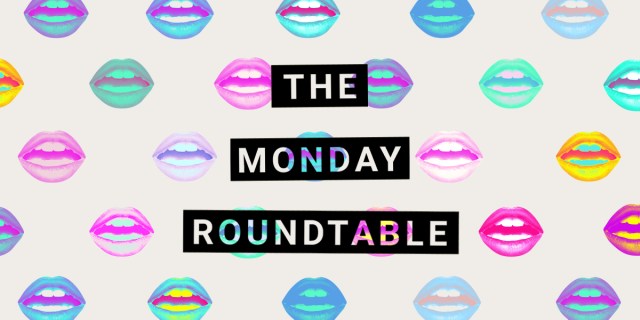Billie Jean King Is This Week’s Modern LGBTQ Trailerblazer #WCW
This post is sponsored by HBO and Gentleman Jack.
Billie Jean King will go down as one of the greatest tennis players — one of the greatest athletes, actually — of all time. 39 Grand Slam titles. 20 Wimbledon victories. And, of course, her Battle of the Sexes win over Bobby Riggs, which sold out the Astrodome and was viewed by more than 90 million people. “I thought it would set us back 50 years if I didn’t win that match” King later said. “It would ruin the women’s tour and affect all women’s self-esteem.” Instead it did quite the opposite: It legitimized women’s tennis, and more broadly, it brought essential positive attention to women’s sports and the women’s liberation movement in the 1970s. Perfect timing, really, as King had just founded the Women’s Tennis Association because the two professional tennis circuits at the time refused to give women tennis players equal pay or prize money compared to male players. In fact, in 1973, the year of the Battle of the Sexes, a woman couldn’t even get a credit card without her husband or father or another male family member signing off on it.
One of the common themes of our Gentleman Jack-sponsored #WomenCrushWednesday series so far has been: The fights our modern LGBTQ trailblazers are winning are fights Anne Lister was engaged with almost 200 years ago. And Billie Jean King’s is no different.
In Anne Lister’s lifetime, there were very few women landowners because a woman’s property was surrendered to her husband at the time of their marriage and she ceased to exist as a legal entity of her own. Land and homes passed from male heirs to male heirs. Lister was in a unique position: Her uncle owned Shibden Hall, in York, and had no sons or nephews to leave it to. “He has no high opinion of ladies,” Anne wrote about him in her diary — but he did have a high opinion of Anne, who had a great mind for finance, the physical strength and desire to work alongside the men on the estate, and absolutely no inclination to marry a man (and therefore surrender Shibden to him). In fact, both Anne’s aunt and uncle knew she preferred the company of women, and they encouraged it.
When Anne’s longtime romantic partner, Mariana Belcombe, announced her plan to marry a man because she needed financial security, Anne pleaded with her uncle to leave all of Shibden Hall to her. Without her own living, she would never be able to live out her dreams of traveling or finding a woman to settle down with. Her uncle agreed, and upon the death of him and Anne’s father, she became the sole owner of the estate.
Even so, she met with mountains of resistance from wealthy male businessmen and bankers — as well as attempts at exploitation and theft — when it came to mining the coal on her property. But she persisted and even, against all advice and thoughts of modern feminine decorum, descended into her mines more than once. “I came up dirty and delighted,” she wrote.
The kind of intimidation and scare tactics men used against Lister were the same ones they used against Billie Jean King two centuries later when she decided to start the WTA. Women were too weak to do the jobs men could do. No one would invest in a woman-run businesses. She’d lose the respect of the people who supported her. She’d overplay her hand and be left with nothing. King refused to capitulate. She believed, more than anything, in the power of her own strength and determination. Without money, there was no power; and without power there was no opportunity for women, no choices. King convinced eight women to join her. Nine women on the original WTA. Today it is the principal organizing body of women’s professional tennis with over 2,500 players from 100 countries who have earned over $146 million in prize money.
Anne Lister was an athlete, too. People always forget that. She beat her brothers at every sport. She walked everywhere. She was the first woman to ascend Mount Perdu, and the first person, period, to scale Mount Vignemale. It’s no 700-win (81.76%) singles record — but maybe that’s because lawn tennis hadn’t been invented yet.
Monday Roundtable: Our Favorite LGBTQ Historical Figures
It’s LGBTQ History Month, and not a moment too soon! It’s absolutely necessary at this moment in time to remember some of the icons of our collective queer past who have overcome all kinds of adversity to change the world and our individual lives. So we’re dedicating this first roundtable of October to our favorite LGBTQ historical figures.
Billie Jean King
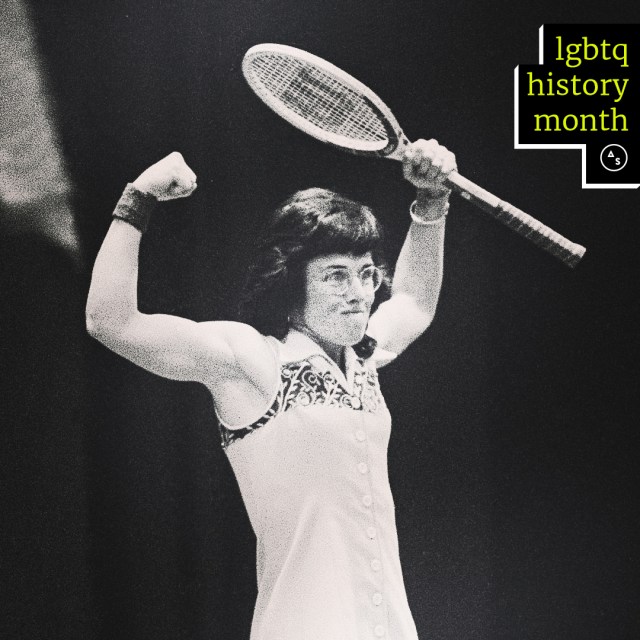
Heather Hogan: I love LGBTQ+ history because LGBTQ+ people have done so many of the best things in this world! It’s hard to choose a favorite; I want to list 100 queer women! I’m going to go with my love, my love, my love Billie Jean King, though. She is, of course, most known for winning the Battle of the Sexes against Bobby Riggs in 1973, on the heels of founding the WTA, which she established, played in, and maintained, all because she refused to accept that women tennis players deserved less money than their male counterparts. Both founding that organization and agreeing to play Riggs were huge risks to BJK herself, and they were huge risks to the feminist movement at large, which she knew. She shouldered that burden with a smile!
It took BJK a long time to come out. Part of it was that she knew her sexuality would hurt the women’s movement and women’s sports; part of it was that she would lose the ability to support herself financially (which she was proven correct about: when she was outed, she lost all her endorsements in a single day); part of it was that she’d grown up with a mother who was absolutely opposed to gayness in every way. When she finally did come out, though, she became a champion for LGBTQ equality and has continued to champion women’s tennis and call out sexism in every nook and cranny of the game. Most recently in this summer’s U.S. Open when Serena faced such sexism and racism from the chair ump. BJK is one of the best tennis players in history, and also she’s just a rad-as-hell badass and very good person. And she has never apologized once for her greatness.
James Baldwin
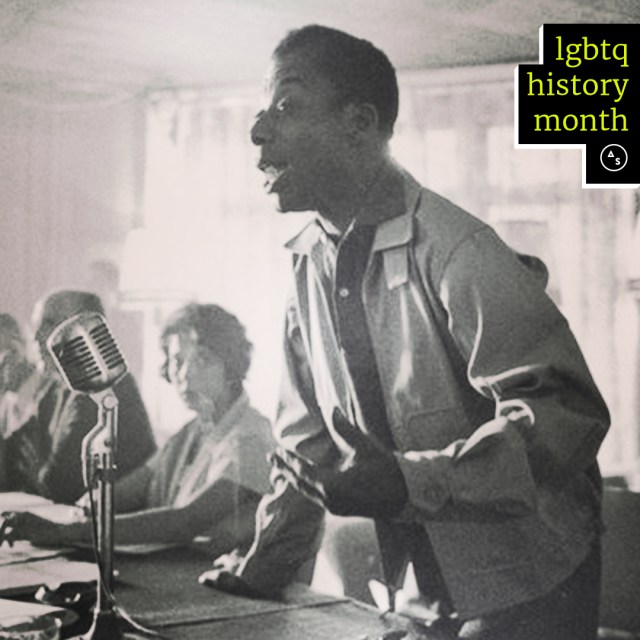
Rachel Kincaid: My favorite LGBTQ historical figure is also my favorite writer is also my idol — longtime readers will probably be sick of me talking about James Baldwin by now but that’s too bad, here we are! Baldwin was born in 1924 in Harlem, where he was raised by his mother and preacher stepfather, and later became a junior minister/child preacher in the Pentecostal church. He left the US at the tender age of 24 to make a life for himself in Paris, finding the weight of American racism was unbearable. His writing career began to take off in Paris, and his second novel, Giovanni’s Room, was his first to deal explicitly with a same-sex relationship. His publisher at the time at Knopf told him:
…I was “a Negro writer” and that I reached “a certain audience.” “So,” they told me, “you cannot afford to alienate that audience. This new book will ruin your career because you’re not writing about the same things and in the same manner as you were before and we won’t publish this book as a favor to you… So I told them, “Fuck you.”
(This was in 1956!) Later, Baldwin left Paris, feeling an obligation to be more involved in the US civil rights movement (although it should be noted he didn’t sign on to the term ‘civil rights movement,’ calling it instead in 1979 “the latest slave rebellion.”). He wrote journalism and essays, including book-length ones like the incomparable The Fire Next Time, which reads just as urgently today. He also made public appearances for speeches, interviews and debates, demonstrating an incandescent speaking presence and rhetorical style that put all his experience from the pulpit to a different purpose. This brief debate on the Dick Cavett show about, essentially, “why it always has to be a race thing” is a good example.
Baldwin did all this while being out and unapologetically not-straight (although he refused to identify with a specific label right up through the end of his life, stating in his last interview, “The word gay has always rubbed me the wrong way. I never understood exactly what is meant by it. I don’t want to sound distant or patronizing because I don’t really feel that. I simply feel it’s a world that has little to do with me, with where I did my growing up. I was never at home in it.”) His openness about his sexuality was often a source of frustration for his allies and enemies alike, but choosing to embody a seeming contradiction was everything that made Baldwin so remarkable. He could be scathing in his cultural critiques and observations, but generous enough to give them; he was clear-eyed and unsentimental about the incredible harm he saw enacted but refused to become cynical in the face of it; he largely denounced the church he had grown up in but in many ways manifested its most admirable principles with his life and work. I love him and his work very much, and think there is an endless amount to learn from him!
Adah Isaacs Menken

Creatrix Tiara: Adah Isaacs Menken was basically Lady Gaga before Lady Gaga’s grandmother was even born. She rose to fame in the mid 1800s via her role in the play Mazeppa, where she put on a flesh bodysuit and rose a horse on stage – both very, very unusual for women at the time. (Burlesque owes a lot to this woman.) She would craft and sell photo portraits of herself to make sure people remembered her the way she wanted to be remembered. She wrote tons of poetry and essays and also had male and female lovers. My favourite part of her story is that she’d never have a consistent answer to questions about her heritage; as someone who hates “where are you from?” with a passion because nobody believes me, I’m often tempted to take on her strategy.
Eleanor Roosevelt
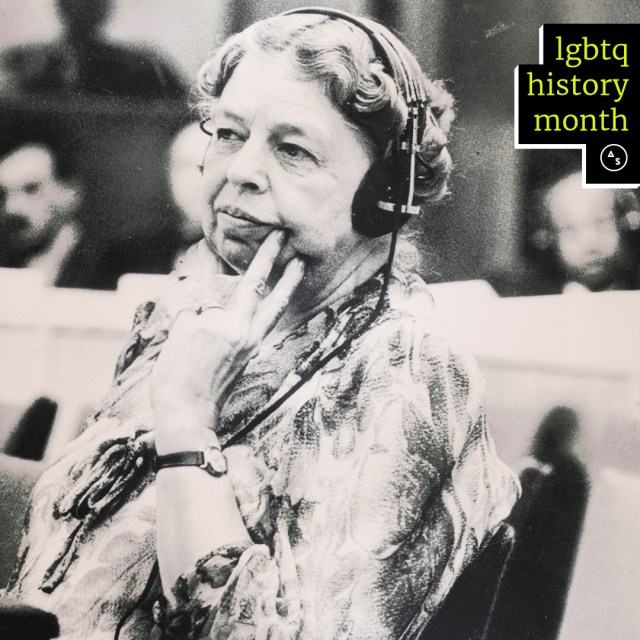
Carrie Wade: Eleanor Roosevelt! Her not-straightness is pretty well established at this point, but for those of you just joining the party, she had a — shall we say — close relationship with Associated Press reporter Lorena Hickok, who lived in the White House at Eleanor’s invitation (!) from 1941 until 1945. Kayla brilliantly recapped their letters to each other on this very website if you’re curious.
Of course, Eleanor stands out even among the most badass American First Ladies. Lots of contemporaries took issue with her being too outspoken, publicly disagreeing with some of her husband’s policies, and taking a progressive-for-the-time stance on racial justice. She didn’t let the bastards get her down and became the first First Lady to hold individual press conferences, write regular newspaper and magazine columns, host her own weekly radio show, and speak at a national political party convention. She was also the only woman appointed to the first American delegation to the UN.
Fun fact: the FDR Memorial in DC includes statues of both Franklin and Eleanor, but never shows them together. (Eleanor’s sits in front of the UN seal and refers to her specifically as “Eleanor Roosevelt: First United States Delegate to the United Nations.”)
Whitney Houston
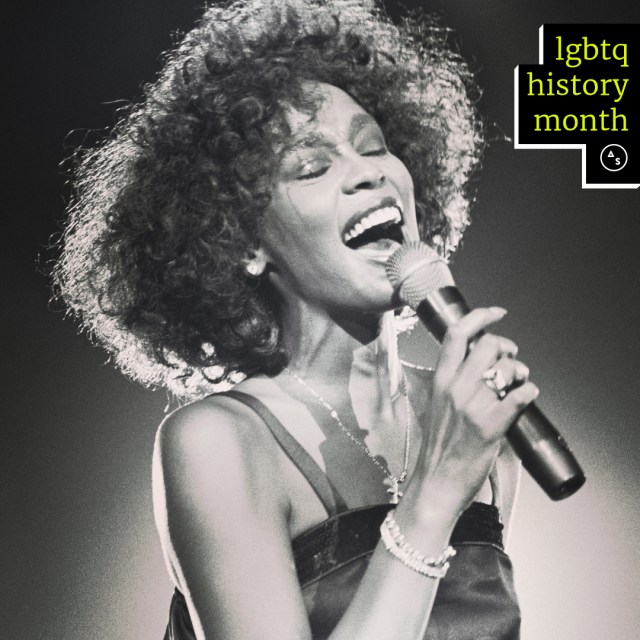
Erin Sullivan: I mean, I’m not sure you would classify her as a historical figure per se, as she was just one of the biggest stars of all time, but Whitney Houston is my bi queen. She deserved so much more than what she ultimately got, in so many arenas of her life, and we really didn’t deserve her! A lot of people either a) do not subscribe to the family/assistant confirmed fact about Whitney that she was romantically involved with her friend/assistant Robyn Crawford or b) haven’t even heard about this family/assistant confirmed fact about Whitney that she was romantically involved with her friend/assistant Robyn Crawford, but that doesn’t mean it’s not true! She wasn’t out, maybe not even to herself, so there wasn’t necessarily an activist or political bent to her, but she’s a good reminder that queer people have always been out here!
Unrelated to a LGBT history, one of my favorite things that I learned in the most recent Whitney documentary was that her performance of the “Star Spangled Banner” in 1991 where everyone lost their minds was that someone tried to send her the orchestra music two weeks in advance so she could get a feel for it, and the day before she was set to sing listened to it for first time for like 30 seconds, didn’t practice, and the next day just walked out, sang it, one time, bloop, record it. Bi-excellence.
Langston Hughes
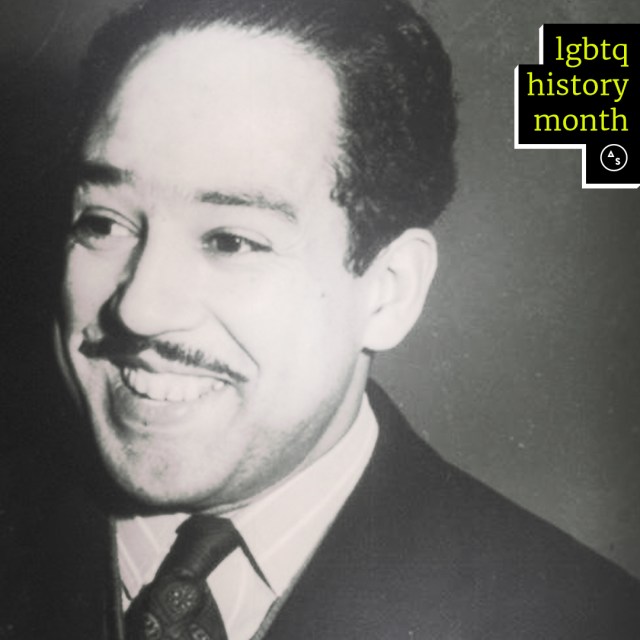
Alexis Smithers: I’m going down memory lane with these apparently but let me tell you about my home boy, Langston Hughes. We all know him, famous gay black poet one of the best writers from the Harlem Renaissance one of the best writers period BUT YOU DON’T KNOW that I’ve been obsessed with him since I was in third grade and my mom got me this picture book called Visiting Langston about this little black girl that visited Langston Hughes’ house and wanted to be a writer and my mom wrote me a note in the cover of the book telling me how much she loved me and the writing I did. I still, to this day, will flat out cry at the memory of it.
We had to dress up/act as poets for my senior class and everyone in the English department literally begged me not to do Langston Hughes (but I waited ’til the last minute so I worked with my boy anyways and I got to argue with Sylvia Plath; it was a good day).
My mom bought me all kinds of copies of his work but the one that sealed the deal for me was his entire work of collected poems. I’m looking at it right now and it weighs so much; I carried it with me when I got Saturday detention for skipping class ’cause I thought it would help me not cry for getting in trouble. I scribbled in the margins of my notebook and memorized “I, Too” whenever white people were too much which is often and I reread and recited the small poem “Suicide Note” over and over my junior year and performed my first feature across a painting of Langston at Busboys and Poets and wrote my first poems after Langston. I know there’s so much he’s done. I get overwhelmed even thinking about trying to tell you in this space. But sometimes, hearing how special other people have been to people I care about makes me want to look them up and that’s what I did here and can you tell I never did very well on school assignments.
Amelia Earhart
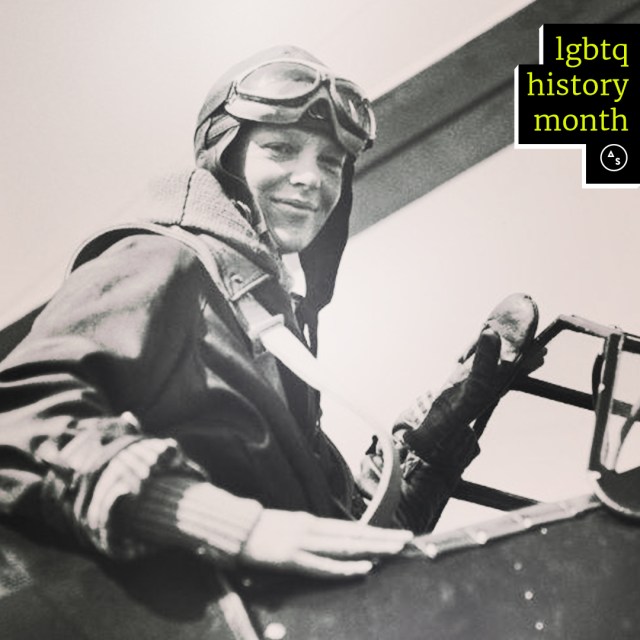
Alaina Monts: My favorite LGBTQ+ historical figure is Amelia Earhart. She was “close friends” with Eleanor Roosevelt, and flew for long distances with a woman-led flight crew. She married a man for convenience and had a strong jawline. She looked great in pants. She has a “steal your girl” smile. I bet her hands were soft. I watched this Netflix documentary about her last year and it definitely convinced me that her plane did not crash but landed safely on an island where she and her lover lived happily ever after.
Sally Ride
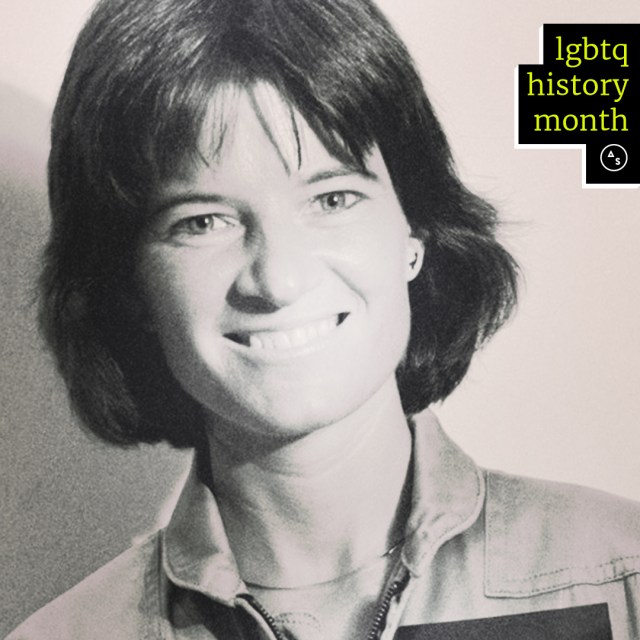
Alyssa Andrews: The idea of a “historical” figure feels like my pick should be plucked from the deep vault, but after (admittedly way too much) mulling, I keep circling back to Sally Ride: conqueror of earth, space, and a queer romantic partnership that stood the test of time. Sally changed the course of history on June 18, 1983 when she flew on the space shuttle Challenger becoming not only the first American woman to go to space, but the first acknowledged* gay astronaut (though, of course, we found that out later). If that’s not the epitome of badass, i don’t really know what is.
P.S. She’s also got a sister named Bear Ride, who’s a gay Presbyterian Minister.
P.S.S. You read that correctly. Her name is BEAR. FUCKING. RIDE.
NASA focused sources still often completely ignore mentioning anything about her queerness in any and all biographies, but she’s really google-able, and this news article is pretty sweet.
Barbara Chirlane Jordan
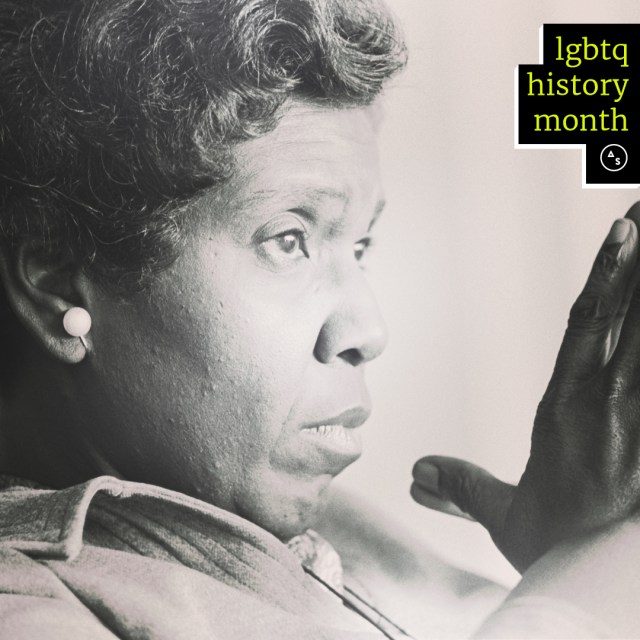
Natalie Duggins: I’ve been thinking a lot about my favorite LGBTQ history figure, Barbara Chirlane Jordan, recently. She was a the lawyer, educator, politician and activist, who found so many ways to etch her name into the history books. She was the third black woman to earn a license to practice law in Texas (1959). She was the first black woman elected to the Texas legislature (1966). She was the first black woman elected to represent the South in Congress (1972) and the first black woman to serve as Keynote Speaker of the Democratic National Convention (1976). But I’ve been thinking of Jordan’s role as a member of the House Judiciary committee (1974), the starting place for impeachment proceedings of federal officers.
Jordan sat on that committee, as an inquisitor, prepared to investigate whether the transgressions of a president had risen to the level of “high crimes and misdemeanors.” She proclaimed, “my faith in the Constitution is whole; it is complete; it is total. And I am not going to sit here and be an idle spectator to the diminution, the subversion, the destruction, of the Constitution,” and then went on to lay out the case for Richard Nixon’s impeachment, piece by piece. She’d strengthen her argument using the words and documents of our Nation’s founders — the same documents that never intended for Barbara Chirlane Jordan to have a seat at that table — to bring down the President.
Jeanne Córdova

Riese Bernard: Listen, founding The Lesbian Tide and generally being a kickass butch lesbian writer and activist is enough but also, Jeanne Cordova left Autostraddle a gift in her estate, which Sally Ride unfortunately did not do, although I do love Sally Ride with all my heart. You can read more about my love for Jeanne Cordova in Thank You Jeanne Córdova, Love Autostraddle Dot Com and Jeanne Córdova Dies At 67: Goodbye to the Activist and Writer Who Lead The Way We’re Going.
22 Lesbian, Bisexual and Trans Women Athletes Who Changed the Game

It’s a common misconception that the women’s sports world is a hotbed of lesbian activity. Like the sports world as a whole, women’s athletics have been dominated by the patriarchy and homophobia for basically ever. In recent years, dozens of women athletes have come out as gay and of course one very famous athlete came out as a trans woman, but this development is relatively new. Women who came out before the last few years risked everything to do so: their endorsements, their fans, their spots on their teams, their livelihoods, and sometimes even their own lives. Below are 22 lesbian, bisexual and trans women athletes who changed their games and changed the game for LGBTQ people by choosing to live openly.
Note: I’m not endorsing or making qualitative assessments of their overall personalities or actions — inclusion on this list does not mean all these women are heroes or angels or activists. The criteria is solely that they are LGBTQ and that they made a significant impact in both sports and queer culture.
Freda du Faur
Mountaineer
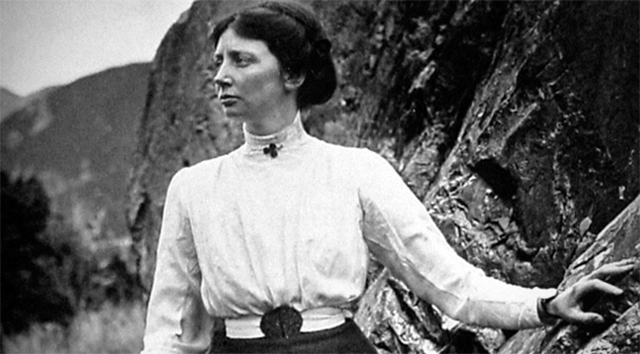
Freda Du Faur was the first female mountaineer in New Zealand, and in 1910, she became the first woman to climb Aoraki / Mount Cook. After her success, she refused to wear dresses or climb with chaperones. She wrote in her journal, “I was the first unmarried woman to climb in New Zealand, and in consequence I received all the hard knocks until one day when I awoke more or less famous in the mountaineering world, after which I could and did do exactly as seemed to me best.” Freda fell in love with her first climbing instructor, Muriel “Minnie” Cadogan, and the two lived together for 19 years until Muriel passed away.
Marion Barbara “Betty” “Joe” Carstairs
Speedboat racer
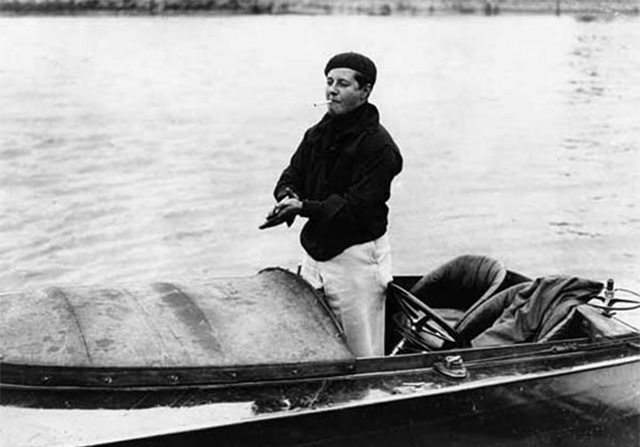
When reviewing her 1998 biography, The Queen Of Whale Cay, The New York Time called Carstairs “a cross-dressing lesbian who had tattoos on her arms, smoked expensive cigars, called herself Joe and was a world champion speedboat racer.” All true! But it gets better. Carstairs moved to Paris when she was 17 and had her first lesbian experience with Dolly Wilde, Oscar Wilde’s niece, about which she wrote: “My God, what a marvelous thing. I found it a great pity I’d waited so long.” Carstairs won the Duke of York’s Trophy, the Royal Motor Yacht Club’s international race, and the Lucina Cup. Then she bought her own island where she kept photographs of the 120 girlfriends who visited her there.
Lily Parr
Soccer
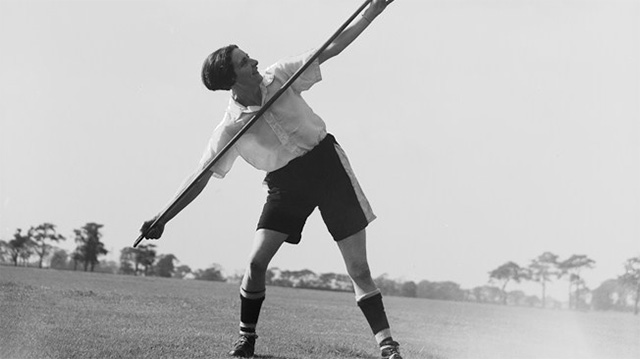
In 1921, the FA banned women from playing soccer on affiliated grounds in England because women were starting to draw bigger crowds than men, largely because of Lily Parr. Standing six feet tall, she started playing professional soccer when she was 14 after she took a munitions assembly job at Dick, Kerr & Co and joined their soccer team for ten schillings per game. She played against men and women and reportedly shot the ball harder than any man. When the women’s league was effectively banned in England, her team traveled to the United States to play exhibition games. Here, newspapers labeled her “the most brilliant female player in the world.” She lived openly as a lesbian with her partner, Mary, until she died of breast cancer in 1978.
Helen Stephens
Track and Field
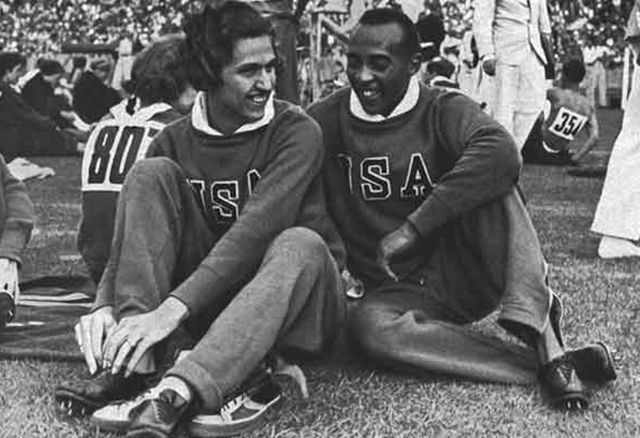
Helen Stephens reportedly never lost a sprint race in her entire life, including the two gold medal races she won in the 1936 Olympics. During her life, she held world records in the 50 meters, 100 meters, 220 meters, shot-put, and standing long jump. She also played professional basketball on a team she owned and managed. Stephens was good friends with Jesse Owens, running in exhibition races with him before the Olympics in Berlin. Sharon Kinney Hanson’s biography, The Life of Helen Stephens: The Fulton Flash, explores her complicated relationship with her own lesbianism. She never came out of the closet. She was, however, instrumental in protesting the IOC’s gender testing methods, which she was subjected to after setting a world record in 1936.
Roberta Cowell
Autoracing
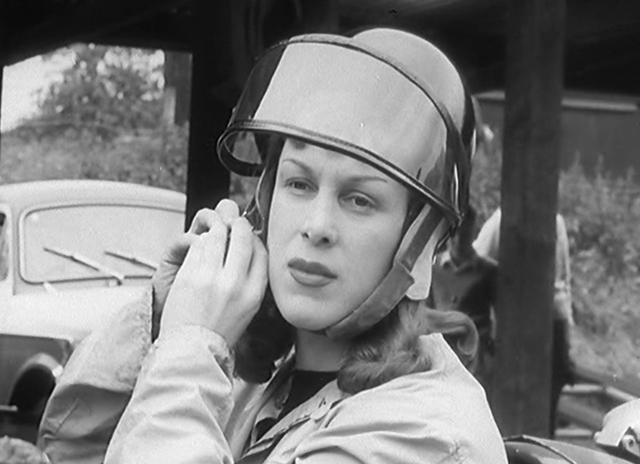
Roberta Cowell is the first known British person to undergo gender confirmation surgery, which she did in 1948 after she came out as a trans woman and met her life partner, Lisa. Roberta had been a celebrated auto-racer before leaving the sport to become a fighter pilot during World War II. She returned to it after the war and after coming out, racing into the early ’60s, and owning fast cars with big personalities for the rest of her life.
Jackie Silva
Volleyball
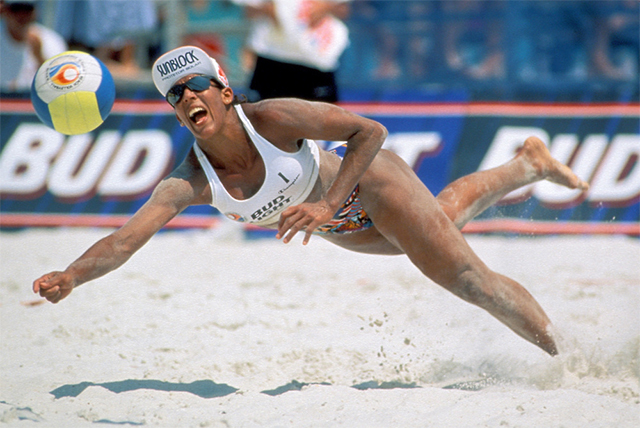
In the 1996 summer Olympics, Jackie Silvia won the gold medal for Brazil in the inaugural women’s beach volleyball tournament. But that wasn’t her first Olympics. Playing for the national indoor team, she helped take Brazil to their first Olympics in 1980 at the age of 14, and then again in 1984. In 2014, Silva married her partner of ten years, dancer Amália Lima.
Babe Didrikson
Literally Every Sport on Earth
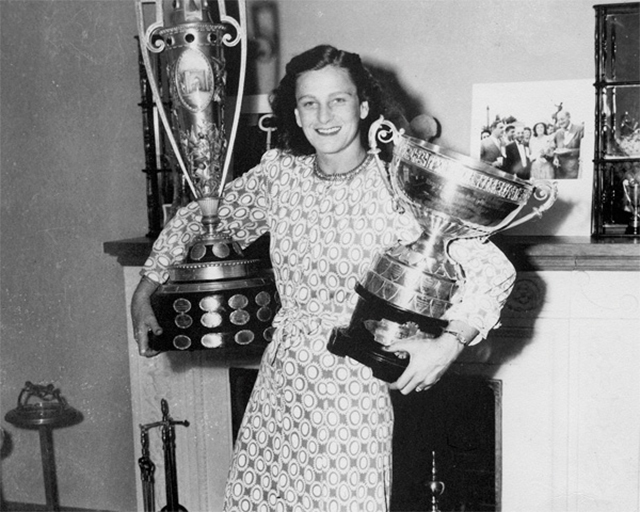
Lots of sports historians consider Babe Didrikson to be the greatest athlete of all time. She played golf, basketball, baseball, tennis, billiards, and ran track and field. She won two gold and one silver medal in the 1932 Olympics, breaking the world record in the 80-meter hurdles and the javelin. Then she started her own professional women’s basketball league, which she called Babe Didrikson’s All-Americans basketball. After traveling around the country doing that for a while, she decided to learn to play golf. She did. And she won 10 major LPGA championships. It was on the golf circuit that she met Betty Dodd, who, despite Didrikson’s marriage, became her lover and lifelong partner. Dodd was with her until the day she died.
Megan Rapinoe
Soccer
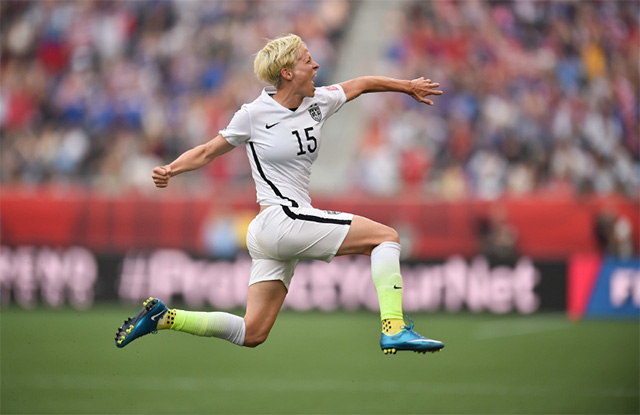
Megan Rapinoe was one of the first popular athletes of the modern sports age to come right out of the closet without apologies. She did so right before the 2012 Olympics in an interview with Out, and then helped lead the USWNT to a gold medal. She also starred on the 2015 team that won the FIFA Women’s World Cup. She’s been nominated for dozens of soccer awards, inducted into the National Gay and Lesbian Sports Hall of Fame, and recognized for her philanthropy and volunteer work, especially with LGBTQ organizations. Rapinoe made evem more headlines in 2016 when she knelt for the national anthem in solidarity with Colin Kaepernick before a NWSL game.
Billie Jean King
Tennis

Billie Jean King is regarded by many historians and sports writers as the greatest women’s tennis player of all time, although she’s hinted in the last few years that she thinks Serena Williams actually owns that title. She won 39 Grand Slams; founded the Women’s Tennis Association as a pushback against the gender pay gap in the sport; and, perhaps most famously, defeated Bobby Riggs in the Battle of the Sexes in 1973. She’s been Sports Illustrated‘s Sportsman of the Year, Time magazine’s Person of the Year, and won a Presidential Medal of Freedom. The WTA trophy is called The Billie Jean King Trophy. The USTA tennis center in New York City where the U.S. Open is played is called the Billie Jean King National Tennis Center. King was outed in 1981 by her girlfriend, Marilyn Barnett; after losing all her endorsements in a single day, she called the relationship a mistake and went back into the closet. She began a relationship with her doubles (and now life) partner, Ilana Kloss, in 1987 and ultimately came out and became as relentless an advocate for LGBT rights as she always has been for gender equality.
Brittney Griner
Basketball

At Baylor University, Brittney Griner became the first basketball player in NCAA history to score 2,000 points and block 500 shots, stats that propelled her to three All-American titles, an ESPY, and AP’s Player of the Year award. They also led to her being the first pick in the 2013 WNBA draft. Griner came out right after the draft in Sports Illustrated, saying, “It’s hard. Just being picked on for being different. Just being bigger, my sexuality, everything.” She’s been to the WNBA all-star game four times, won a WNBA championship, and this year she led the league in scoring.
Martina Navratilova
Tennis
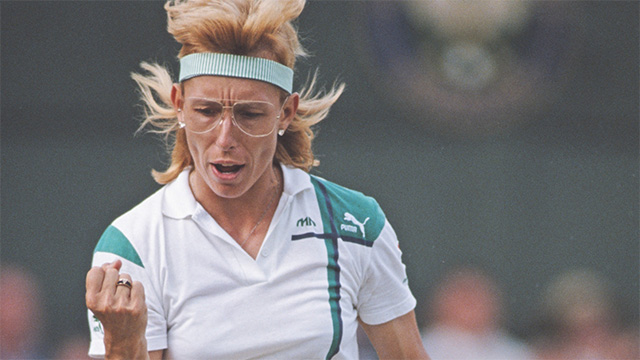
Another lesbian, another contender for greatest women’s tennis player of all time. Martina Navratilova played professional tennis for four decades and holds records for being ranked the world’s number one player in singles and doubles at the same time (over 200 weeks each). She won 18 singles Grand Slams and 31 doubles Grand Slams. Navratilova came out in the New York Daily News in 1981, after becoming a U.S. citizen. In 2014 she married her longtime girlfriend, Julia Lemigova, after proposing to her at the U.S. Open.
Renee Richards
Tennis
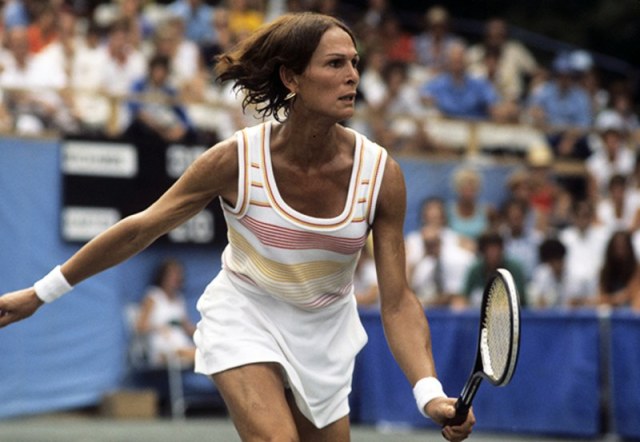
Dr. Renée Richards was a professional tennis player in the ’70s. After coming out as trans and undergoing gender confirmation surgery, Richards was denied entry into the 1976 US Open. She took the case to the New York Supreme Court and won. Judge Alfred M. Ascione ruled: “This person is now a female.” Ascione called the Barr body test, which the USTA wanted Richards to pass to play, “grossly unfair, discriminatory and inequitable, and a violation of her rights.” Richards is one of the first openly trans athletes and was an outspoken advocate for trans equality in sports for decades, even after she left the tennis circuit to become an ophthalmologist.
Sarah Vaillancourt
Hockey

Sarah Vaillancourt, who spent ten years on the Canadian women’s national hokey team roster, won two Olympic gold medals, a gold medal in the World Championships, and four silver World Championship medals. A nice addition to the Patty Kazmaier Award and the Ivy League Hockey Player of the Year Award she won at Harvard. Vaillancourt came out during her time there, telling a reporter later: “There were other gay girls on the team, but no one ever talked about it or went on about it. I came in and was like, ‘I’m into girls,’ ‘I think this girl’s hot,’ and that’s just how it is. Some of the girls were traumatized, but now when we have reunions, we laugh about it.”
Abby Wambach
Soccer
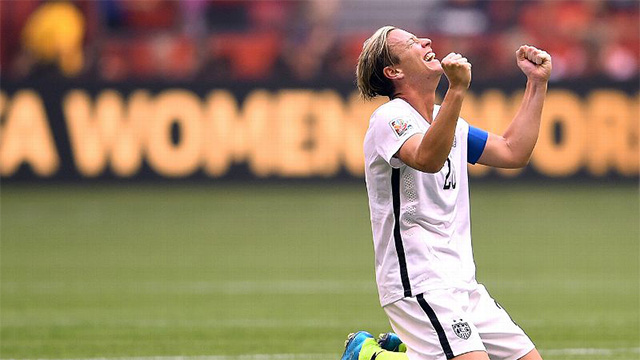
Abby Wambach is one of the most celebrated soccer players in history. With 184 goals to her name, she’s the highest all-time goal scorer in international soccer (for both men and women). She played on the USWNT for 13 years and took home FIFA World Player of the Year honors in 2012. She has two Olympic gold medals and a FIFA Women’s World Cup. She was the first soccer player to receive the Associated Press’ Athlete of the Year award. Wabach married teammate and longtime girlfriend Sarah Huffman in 2013, telling reporters at the time that she’d never felt the need to come out of the closet because she was never in the closet. After their marriage ended, Wambach married “Christian mommy blogger” Glennon Doyle Melton.
Diana Nyad
Swimming
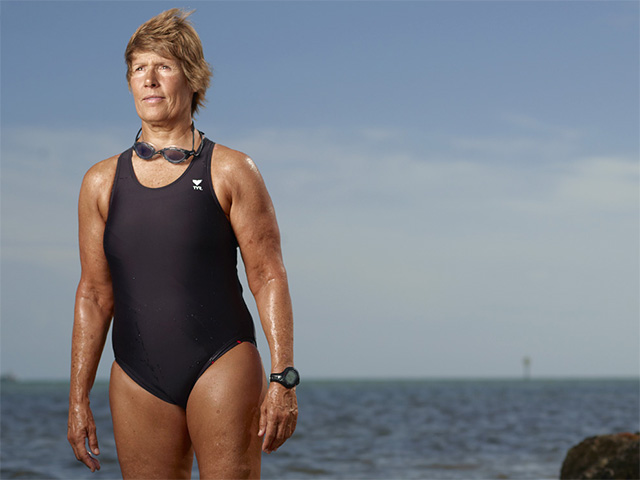
In 1975 Diana Nyad swam around Manhattan. In 1979 she swam from The Bahamas to Florida. When she was 64 years old, in 2013, she became the first person in history to swim from Cuba to Florida without a shark cage. Not long after, she won the ESPN Sports Science Newton Award for Outstanding New Limit and was named by Marie Claire as participating in one of the 8 Greatest Moments for Women in Sports. (Billie Jean King also made that list.) Nyad has spoken repeatedly about how her journey into competitive swimming started because she was trying to overcome the anger she felt from being sexually assaulted, beginning when she was 14 years old by her swimming coach.
After her historic swim from Cuba, Nyad talked about coming out in her 20s: “The president of ABC News and Sports used to have a lunch every Wednesday and I’d take my girlfriend and people would pull me aside and tell me not to. But if you said to me today, ‘You would have been the next Diane Sawyer but you’d have to totally closet that whole gay life and be out about town with a nice-looking guy’, I’d say, ‘Not in a million years, never.'”
Seimone Augustus
Basketball
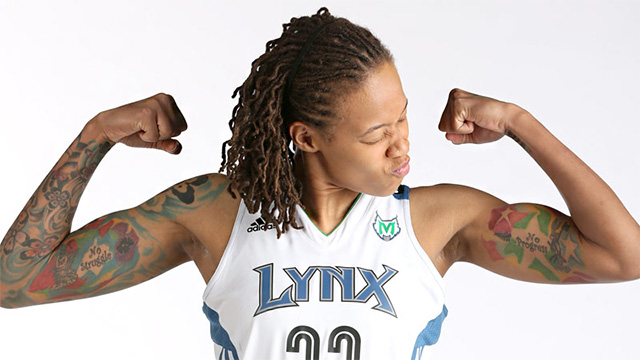
From the moment she walked onto the court at LSU, where she went to three Final Fours and won two Wooden Awards, Seimone Augustus has been a superstar. Actually, she was a superstar before that. In high school Sports Illustrated For Women called her the next Michael Jordan. Rightly so. After being drafted first in 2006, she’s won four WNBA titles with the Lynx, played in seven all-star games, and been named one of the league’s 20 best all-time players. Oh, right, and she has two Olympic gold medals. In 2012, when Minnesota’s election included a referendum to ban gay marriage in the state, she came out, saying: “Everyone thinks that the WNBA is one big lesbo party anyway.” When she married her longtime girlfriend, LaTaya Varner, she wrote a beautiful essay in the Players’ Tribune called “It Is So Ordered” and it is 100% guaranteed to make you cry.
Gigi Fernández
Tennis
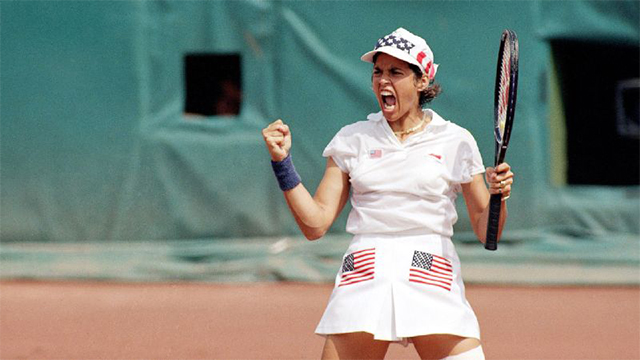
Tennis superstar Gigi Fernández was the first Puerto Rican-born athlete to win an Olympic gold medal. In fact, she and her doubles partner, Mary Joe Fernández Godsick, won two. The first in the 1992 Barcelona Olympics and the second in 1996 in Atlanta. She also won 17 Grand Slam doubles titles in her career. She is married to former LPGA superstar Jane Geddes and is, to this day, an outspoken advocate for LGBT and racial equality, recently going in on notoriously anti-gay tennis legend Margaret Court on Twitter and remaining a critic of the Trump administration, particularly in the face of Puerto Rico’s recent humanitarian crisis after Hurricane Maria.
Caitlyn Jenner
Decathlon
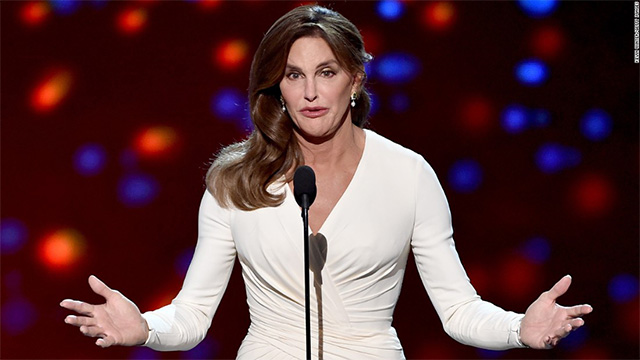
Caitlyn Jenner is likely the most famous trans person in history. Her coming out was covered by media outlets all over the world and witnessed by millions of people, many of whom watched her reality series I Am Cait which included crossovers with the Kardashians and even a guest visit by Kanye West. Jenner, of course, won the decathlon in the 1976 Olympics, breaking her own world record for a third time in the process. Jenner is the quintessential Wheaties box athlete and was the first American to take a victory lap with the flag after winning an Olympic event.
Ireen Wüst
Speedskating
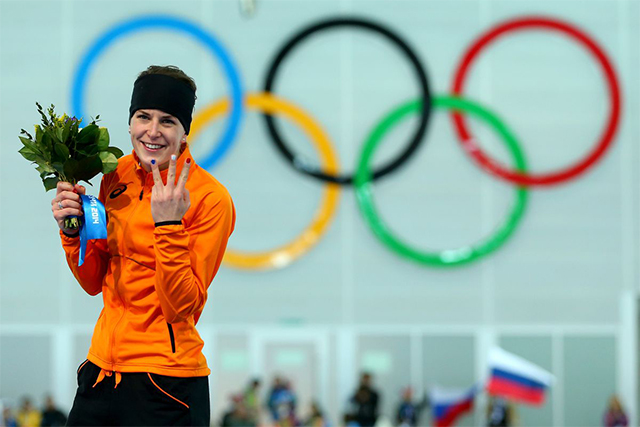
Of the 110 medals the Netherlands have won at the Olympic Winter Games, 105 of them have come from speed skating. Ireen Wüst brought home eight of them. And she’s not done yet. She was the youngest Olympic medalist from the Netherlands at just 19 and she’s got her eyes set on PyeongChang in 2018. She’s won so many world championships and European championships that Reuters elected her Sportswoman of the World in 2014. Wüst has been one of only a handful of openly gay athletes competing in the last few Olympics, something that brought her even bigger attention than usual in Sochi in 2014 due to Russia’s anti-LGBT laws/state sponsored propaganda. She was the first gay athlete to medal at those games, and ultimately won five medals, making her one of the most decorated athletes of the Russian games.
Natasha Kai
Soccer
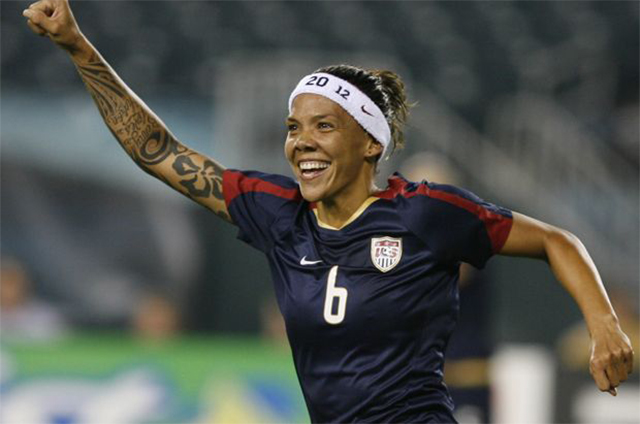
Natasha Kai was one of the first U.S. Olympians to come out, which she did casually in an interview with NBCOlympics.com in 2008 by mentioning that was going through a breakup with her girlfriend. As one of only three out athletes on the U.S. Olympic team in Beijing, she helped the USWNT bring home the gold medal that summer, scoring the winning goal in overtime to lead the U.S. past Canada in the quarterfinals. As with her sexuality, Kai never shied away from talking about the pressure of playing soccer at the highest level. Last year she wrote a powerful, candid essay for Vox called The dark side of being an Olympic athlete: it’s a roller-coaster ride.
Nicola Adams
Boxing
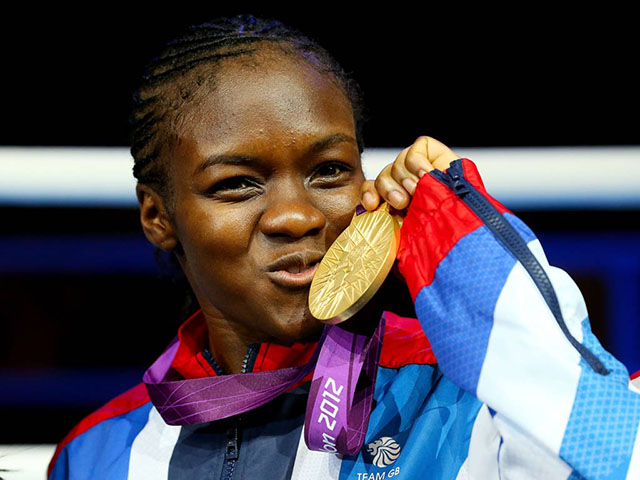
In 2012, British boxer Nicola Adams became the first woman to win an Olympic boxing title. In 2016, she won another gold. It had been her dream since she was a little girl, a decade before women’s boxing was even considered as an Olympic event and at a time when her asthma was so bad her doctor told her mom not to let her run. After winning her first professional match last year, she proposed to her girlfriend, Mexican-American boxer Marlen Esparza. You should do yourself a favor and read The Guardian’s profile of Adams, which includes this glorious paragraph:
Esparza is with her today, advising her on the photoshoot, telling her how hot she looks. The pair seem deliriously in love; and theirs must be one of the most romantic stories in the history of boxing. In her new autobiography, Believe, Adams says that when she was first introduced to Esparza, she was so taken by her she could not speak – nor the second time they met. The third time, she couldn’t stop talking. While Adams is having her photograph taken, Esparza tells me this is all true; that when they met she thought Adams was plain weird. But not for long.
Sheryl Swoopes
Basketball

These days you can’t turn around without seeing a WNBA player come out, but when Sheryl Swoopes did it in 2005 it was a bombshell that absolutely rocked the sports world. Swoopes was the first player to sign with the WNBA, after leading the 1996 Olympic team to a gold medal in Atlanta. She was the most known and most recognizable women’s basketball player in the entire world for decades. She even had Nikes named after her. Sheryl Swoopes wasn’t a basketball player; she was the basketball player, the one on whom women’s professional basketball put its hopes and dreams when it toured around the country in 1995 trying to get people excited enough to support the women who would ultimately make up the WNBA. In total she won three Olympic gold medals, the Naismith Award, four WNBA championships (and dozens of individual WNBA awards), and has already been inducted into the Women’s Basketball Hall of Fame.
When she came out, she told ESPN: “It doesn’t change who I am. I can’t help who I fall in love with. No one can … Discovering I’m gay just sort of happened much later in life. Being intimate with [Alisa Scott] or any other woman never entered my mind. At the same time, I’m a firm believer that when you fall in love with somebody, you can’t control that.”
Swoopes’ relationship with Scott ended in 2011 and in 2017 she married her male partner, Chris Unclesho. Much has been written about Swoopes’ decision to call herself a lesbian and not bisexual during her relationship with Scott, but as is always the case with these discussions, queer language is constantly evolving and never precise and everyone’s decisions are informed in real-time by their own experiences. The fact that remains is that Swoopes risked as much coming out in the sports world in 2005 as Ellen did coming out in the TV world in 1996. She changed everything.
A Reminder Note: I’m not endorsing or making qualitative assessments of their overall personalities or actions — inclusion on this list does not mean all these women are heroes or angels or activists. The criteria is solely that they are LGBTQ and that they made a significant impact in both sports and queer culture.
“Battle of the Sexes” Is a Triumph for Sports Movies and Lesbians
When Bobby Riggs missed the drop shot that clinched Billie Jean King’s straight-set victory in the final minutes of Battle of the Sexes, the people in my packed theater in New York City burst into cheers. For 20 minutes they’d been hanging on every volley, gasping at every serve, hissing their approval as cross-court winners whizzed from Billie Jean’s racket, as if they were watching a real tennis match unfold to decide the fate of feminism, instead of a fictional reenactment of a forty-year-old sporting event. “Billie Jean King is a hero!” an older man in front of me whispered loudly to his wife. She patted his hand. She said, “I know.”
Battle of the Sexes, which stars Emma Stone as King and Steve Carrell as Riggs, is so many movies. It’s a comedy about a charming, washed-up, middle-aged gambling addict looking for a little notoriety and one more hustle. It’s a period drama about a group of women athletes trying to get equal pay and a little respect. It’s a sports movie, complete with breathless action sequences, overwrought crowd reactions, and a soaring score. It’s a biopic about a legend. And it’s one of the best lesbian films I’ve ever seen.
Billie Jean King — a gay icon, a feminist idol, one of the greatest athletes in history, an unshakable pillar of indomitable humanity here in 2017 — becomes even more powerful in Battle of the Sexes, but the film also offers audiences the gift of undoing her invincibility in our imaginations by allowing her to fall in love.
Her name is Marilyn Barnett and she’s a stylist. She’s doing Billie Jean’s hair for a photoshoot to celebrate the press conference that’s launching the Women’s Tennis Association into existence. It’s casual laughs and small talk until Marilyn’s hands start to linger in Billie Jean’s hair; until Marilyn leans closer to whisper near Billie Jean’s ear; until Marilyn compliments Billie Jean’s eyes, her nose, her mouth. The intimacy is almost stunning, as the camera closes in on them and the microphones do too. Their faces. Their voices. The snip of Marilyn’s scissors. “Is that… perfume?” The look on Billie Jean’s face as understanding dawns on her: what she wants and has always wanted. They find themselves at a bar later, and in a hotel room — and, ultimately, on the road together with the eight other players who made up the first Virginia Slims Tour.
The tour, in real life and in the movie, was a tag-team effort between Billie Jean King and World Tennis Magazine founder Gladys Heldman to combat pay inequality on the professional tennis circuit. They argued that women pulled in the same size crowds as the men, but USTA execs refused to give women more than a fraction of the men’s winnings because they weren’t as fast or as strong. When King left the USTA to start her own league, she had everything to prove, which is why she eventually agreed, at 29, to play 55-year-old self-proclaimed “male chauvinist” Bobby Riggs. He’d already defeated superstar Margaret Court, and King realized the shortest path to pay equality in women’s tennis — and women’s pay equality, full stop — was through Riggs. She also knew it was the most dangerous. In later years, King told reporters she felt sure, at the time, that if she lost she would set the women’s movement back 20 years.
Billie Jean carries the weight of her affair with Marilyn; the knowledge that she’s acting on romantic feelings that could, if made public, destroy her career; the pressure of the first women’s professional tennis tour; the hype surrounding her match with Riggs; and the hopes and dreams of millions of women around the world.
The irony of Battle of the Sexes is how hard it has to work to try to make Carrell’s Bobby Riggs a character of equal importance. It touches on his marital problems, his parenting problems, his gambling addiction, his bombastic sexism, his training style, his narcissism, his sponsorships, what he wears, what he eats. But no matter how many narratives weave their way around him, Riggs is never more than a distraction.
Many male movie reviewers (so: the majority of movie reviewers) have found the film’s depiction of Riggs & Co’s sexism unbearable. Before ultimately deciding it was okay for people to watch, David Edelstein over at New York Magazine mocked the “smirkingly chauvinistic chauvinist Jack Kramer” who “smirks chauvinistically,” while also calling the film “feminist propaganda” and part of the “feminist and gay agenda.” As if watching a complicated, accomplished, unapologetic woman face off against a misogynist clown in the middle of a media circus is just so very outside the bounds of reality. As if that same misogynist clown didn’t once offer Serena or Venus Williams a million dollars to face off against John McEnroe. As if John McEnroe didn’t come unglued when he found out Serena laughed when she heard the offer. Battle of the Sexes is set lushly in 1973, but it’s also not.
It does oversimplify things. Billie Jean King was tortured by her sexuality; her parents were so homophobic she wasn’t able to come out to them until she was 51. Everyone who knew about her sexuality told her it would shatter women’s professional tennis if it became public. She developed an eating disorder as she tried to cope with the pressure of staying closeted. When she was outed by Marilyn Barnett in the early ’80s it almost ended her career; she lied about the depth and length of their relationship and went immediately back into the closet. Her loving and supportive ex-husband, whom she has remained close to throughout her life, told Ms. magazine in 1981 that she’d had an abortion without her permission. Another media blitz followed. She was forced to play tennis long past the age at which she wanted to retire because she lost all her endorsements — totaling $2 million, more money than she made in winnings her entire career — in a single day when she was outed.
But one of the beauties of stories is their ability to bend space and time. In 1973, Billie Jean King beat Bobby Riggs in The Battle of the Sexes in front of an audience of over 50 million people in 37 countries. In doing so, she pushed feminism forward in incalculable, exponential ways. In 2017, Billie Jean King has been awarded the Presidential Medal of Freedom, inducted into the Tennis Hall of Fame, is the namesake of the tennis center where the U.S. Open is played, and lives with her life partner, Ilana Kloss. Those are the true bones of then and now.
In the closing scene of Battle of the Sexes, Billie Jean emerges from the locker room where she’s just broken down in private for the first time: sobbing, heaving, gasping relief. Alan Cummings’ gay designer Ted Tinling pulls her aside and promises her that one day they’ll be free to love who they love. He assures her that her victory moved them one step closer to that day. Billie Jean’s eyes are hope and disbelief. She half-smiles and leaves that dream behind, walks to the center of the Astrodome, the court where she defeated Bobby Riggs, a thousand women waiting to watch her dance.
Is Tennis Full of Lesbians?
It’s that time of year when we all tune in to ESPN and watch our favorite live gaming event of the year, The French Open! And just in time, retired Australian tennis player Margaret Court has filled the entire world in on tennis’ greatest secret: tennis is full of lesbians!

A young Margaret Court, who is not a tennis lesbian.
I for one, was shocked—shocked—by this breaking news. Tennis? Full of lesbians? Absolutely not. Dana Fairbanks was the first tennis lesbian I’d ever heard of! Despite my love for field hockey in high school, though, I’m not the sportiest of queers, so I knew it was possible I was just ignorant about tennis lesbianism. As a Gemini, I felt it my duty to correct this lack of knowledge, and so I went digging.

Dana Fairbanks: professional tennis lesbian full of feelings
In an interview with 20Twenty Vision Christian Radio, Court is quoted saying, “I mean, tennis is full of lesbians[!]” As a younger tennis player, she remembers there being “only a couple there” but that they had tons of parties, and always brought the newer, younger tennis lesbians with them to parties so that they could be around their heroes. How thoughtful. Thanks older lesbian tennis players!

Martina Navratilova with perfect tennis face
Court also stated that more children are LBGTQ+ because of “communism”, saying that “there’s a whole plot in our nation, and in the nations of the world, to get the minds of the children.” I don’t disagree. Communism is a great way to reach children. Resource sharing? Into it. (Unfortunately, it’s actually not Communists or queers attempting to penetrate children’s minds, it’s folks with far more devious motives.)

Billie Jean King: power tennis lesbian who KaeLyn once saw speak at a YWCA luncheon last year where she hit signed tennis balls directly into the audience
As a serious investigative journalist, I knew I needed to do further research. After all, there’s only so much you can learn from a Buzzfeed news article and a 45 minute interview. Is tennis full of lesbians? The internet, and by “the internet” I mean my co-workers on Slack, had a lot more to say about this than I expected. Riese Bernard, Autostraddle’s CEO had this to say, “Tennis has been a longstanding situation for lesbians. Dana Fairbanks was based on a true story. Power lesbian tennis players cavorted secretly in Palm Springs in the 80s and 90s. These are all true facts I cannot provide sources for, but I’m confident about them. Also, Some of the first out lesbians ever, Billie Jean King and Martina Navratilova, were tennis players.” Kayla K, a Staff Writer, said that “Tennis is def full of lesbians!!” citing that, “There was sooooo much lesbian drama on my HS tennis team. My doubles partner was in a secret relationship with another girl on the team it was a whole thing.” Fascinating.
Can’t argue with sound logic and personal anecdotes, right? Some naysayers disagree. Molly Priddy, Autostraddle’s own Feelings Rookie said, “Sometimes I think the mandatory skirts deterred a good many of our more masc[uline] of center athletes,” while Erin Sullivan believes, “Tennis is not full of lesbians but I welcome an upswing!!” Perhaps tennis is full of lesbians who haven’t come out yet? Only time will tell.

Gaby Sabatini may or may not be a lesbian, but she is flagging for fisting.
I also conducted a very official poll on Twitter, seeking the public’s opinion on this vital matter, and just like the staff of Autostraddle, they’re split! As of the writing of this, 46% of poll takers believe that yes, tennis is full of lesbians, while 54% answered either “no” or “just Dana Fairbanks”. Still no straight (pun intended) answer.
https://twitter.com/firecrackerroot/status/869977137809379340
According to one specific forum thread from the tennis side of the internet, which has apparently sat dormant since around 2002, while tennis may not be full of lesbians, there are definitely some out there. And according to Wikipedia’s dynamic list of LGBT Sportspeople there are or have been at least twelve non-fictional tennis lesbians in all of time. I’ve organized them all in a list for you.
Tennis Lesbians
- Dana Fairbanks (fictional, but real in my heart)
- Billie Jean King
- Martina Navitalova
- Casey Dellacqua
- Amelie Mauresmo
- Gaby Sabatini???
- Beatriz “Gigi” Fernandez
- Helen Jacobs
- Ilana Kloss
- Hana Mandlíková
- Lisa Raymond
- Renée Richards
- Rennae Stubbs

Hana Mandlíková: the soft butch who just made me interested in tennis.
One of these lesbian tennis players, the legendary Martina Navratilova, has a very solid theory regarding Court’s statements: “It is now clear exactly who Court is: an amazing tennis player, and a racist and a homophobe.” Good point.
So, is tennis full of lesbians? The jury’s still out (another pun!). If I’m being honest, I don’t actually know how many women tennis players there are right now, period. Can’t be more than like, what, 40? If my estimates are correct, then that means that at least 25% of women tennis players are lesbians right now at this minute. Maybe even more! And this is just the tip of the iceberg, and according to Margaret Court, “you know, what you get at the top is often what you’ll get right through that sport.” Seems clear enough to me.
Daily Fix: Emma Stone and Elizabeth Banks Will Both Play Billie Jean King And Other Exciting Pop Culture Stories
Happy Wednesday, snozzberries! This is your weekly Pop Culture Fix, the place where we talk about the queer/feminist things that are happening in the world of entertainment that don’t require a 5,000-word think piece!
Hollyweird
Lily Motherfucking Tomlin, Y’all
Lily Tomlin‘s Grandma (which also stars Laverne Cox, remember) has garnered so much good buzz at the Tribeca Film Festival that people are already whispering about an Oscar nomination for Tomlin. Flavowire says that in addition to substantial, “juicy” writing for Cox:
[Writer/director Paul Weitz] writes a leading role for Tomlin that’s worthy of her considerable talents. She’s a hellraiser, fiercely protective and tough as nails, yet never reduced to merely that (and she doesn’t always win her battles, sometimes to great comic effect). Her dialogue is sharp and quotable without feeling “written” (as it might coming out of the mouth of a lesser actor), because Tomlin so effortlessly projects bristling intelligence. It’s a wonderfully, wickedly funny performance.
The New York Times thinks Tomlin is pretty perfect too:
Lily Tomlin, giving a career-capping performance, plays Elle Reid, a renowned poet and outspoken misanthrope who is broke and still recovering from the death of a longtime female partner. When her 18-year-old granddaughter shows up needing $600 for an abortion scheduled that very afternoon, they seek the money from Elle’s past friends and lovers. Elle’s raw, pungent remarks are brightened by Ms. Tomlin’s twinkle, but her character’s bitter, tell-it-like-it-is attitude represents a quaint countercultural sensibility curdled by disappointment and age
Tomlin stopped by HuffPo yesterday to talk about a whole lot of things, including being a lesbian in Hollywood in the ’70s.
Glass Ceilings
+ Variety just released their Power of Women issue, so they’re unloading loads of content about about lady things. For example, this three-year study that confirms how shitty it is to be a female director. It features quotes like: “Nearly half of the industryites surveyed believe that female-directed films appeal to a smaller audience than pics directed by men.” And: “Across 1,300 top-grossing films from 2002 to 2014, only 4.1 percent of all directors were female.” And why? Female directors’ “lack of ambition,” of course. And how they “‘can’t handle’ certain types of films or aspects of production, such as commanding a large crew.”
+ Patricia Arquette‘s speech at the Golden Globes drove Meryl Streep over the edge, I think. She has had it with ageism and sexism in Hollywood! This week she announced she’s melting down her Oscars and selling them off and using the money to fund a screenwriting lab for women over 40. (She’s not really melting down her Oscars; she’s using Paypal like regular America to fund the workshop.)
Tennis Pros
Emma Stone sure is going to play Billie Jean King in Fox Searchlight’s Battle of the Sexes. Fox will be fighting the clock against HBO because it has a similar film in the works, starring Elizabeth Banks in the lead role. Two competing BJK biopics? WHAT A TIME TO BE ALIVE. Both films will apparently land in 2016.
Teevee
Renewals and Cancelations
It’s the time of year where networks are rolling out renewals and bringing down the hammer with cancellations. Here’s a run-down of what we know about the queer shows you watch.
+ Everyone’s been wavering on One Big Happy, but TV By The Numbers now says it’s likely to be cancelled.
+ Netflix ordered a fourth season of Orange is the New Black.
We’ll keep you updated!
Knock Knock, It’s Tig Notaro
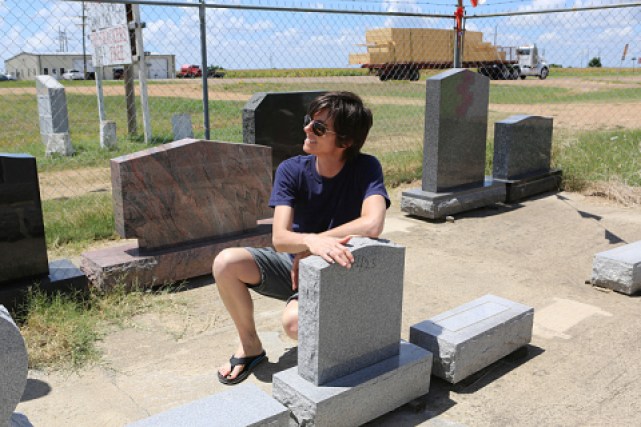
Photo courtesy of Showtime.
Tig Notaro’s cross-country road trip documentary, Knock Knock, It’s Tig Notaro, premiered on Showtime late last week, and the reviews have all been pretty great. Flavorwire says: “What you will find, however, is part stand-up, part buddy comedy, and part road trip documentary — and an oddly cathartic one, at that.” Wired thinks it’s amazing (and dark). The A.V. Club agrees. The New York Times is really the only major detractor. They think Tig’s “meta-Americana” can be “awkward and slightly condescending.”
Wham! Pow! Superheroines On-Screen!
Avengers: Age of Ultron is almost here, and so is Ellen’s supporting role.
After getting the short end of the costume stick in a failed Wonder Woman TV pilot, Adrianne Palicki is finally getting her own superhero show. She’ll continue her role as Mockingbird in a new Agents of S.H.I.E.L.D. spin-off. The Captain Marvel movie has hired two female writers to bring Carol Danvers to the big screen. Director Michelle MacLaren left the much (and forever) anticipated Wonder Woman movie, but rumored Thor 2 director Patty Jenkins has decided to take up the mantle of the world’s most famous female crime fighter.
Ta-Nehisi Coates gave a fascinating interview to Vulture about the role of superhero comics in changing the world.
But comics companies have started to explicitly say, “We are being more diverse and inclusive,” which is much less coded than a lot of the efforts at diversity in the past.
Marvel opened the doors, right? You have Storm, there’s a black Iron Man in the ’80s, the second X-Men generation — you have the Native American Thunderbird. You have heroes that look all sorts of ways. When I was a kid, I knew that superheroes were not exclusively white and male. And if you have fans who grow up with that, they reach a certain age and they expect you to go to another level. Beyond that, it costs comic books way less than movies to do diverse things. They ain’t got to worry about casting somebody who is going to bring in box office.
Musics
Yesterday, the Michigan Womyn’s Music Festival announced that this year’s 40th anniversary festival will be its last. From the official Facebook announcement:
We have known in our hearts for some years that the life cycle of the Festival was coming to a time of closure. Too often in our culture, change is met only with fear, the true cycle of life is denied to avoid the grief of loss. But change is the ultimate truth of life. Sisters – I ask you to remember that our 40 year Festival has outlived nearly all of her kin. She has served us well. I want us all to have the opportunity to experience the incredible full life cycle of our beloved Festival, consciously, with time to celebrate and yes, time to grieve.
There have been struggles; there is no doubt about that. This is part of our truth, but it is not–and never has been–our defining story. The Festival has been the crucible for nearly every critical cultural and political issue the lesbian feminist community has grappled with for four decades. Those struggles have been a beautiful part of our collective strength; they have never been a weakness.
For more about the festival’s decline, check out Riese’s longform piece from last summer, Michfest Could Change Its Trans-Exclusionary Policy Only If It Tried, Only If It Wanted To.
+ Fun Home: The Musical opened this weekend to fantastic crowds and reviews. The New York Times lost its damn mind over it. I haven’t seen a review this good in their theater section since Neil Patrick Harris opened Hedwig and the Angry Inch. To wit:
“Fun Home” knows where you live. Granted, it’s unlikely that many details of your childhood exactly resemble those of the narrator of this extraordinary musical, which pumps oxygenating fresh air into the cultural recycling center that is Broadway.
[…]
But this production has only improved, not least because of its having to be reimagined for a theater-in-the-round space. (The Public production was on a proscenium stage.) The audience becomes, more than ever, part of the Bechdel family circle. For better or worse — and for me shows this cathartic are only for the better — we’re home.
Also.Also.Also
Netflix has officially ordered 13 episodes of Fuller House. Next up, Saved By the Bell: Shady Pines.
And anyway, this is how you cuddle with a pony. (Thanks, Cute Overload!)
